Investigating the Negative Effects of Open Data on Business Innovation
VerifiedAdded on 2020/03/04
|15
|2781
|346
Project
AI Summary
This research proposal investigates the negative impacts of open data sources on business innovation. The study aims to evaluate existing literature, identify both direct and indirect influences on businesses, and distinguish between positive and negative effects. The project scope focuses on various business organizations and the potential drawbacks of using open data, acknowledging a gap in research concerning the negative aspects of open data sources. The methodology includes qualitative and quantitative research methods, sampling techniques, and data collection methods. The research questions address the negative impacts, barriers to innovation, and major drawbacks. The proposal outlines research limitations and a two-year time schedule for data collection, analysis, and conclusion development. The conclusion emphasizes the importance of identifying negative impacts to understand the complete picture of open data's effect on business innovation.
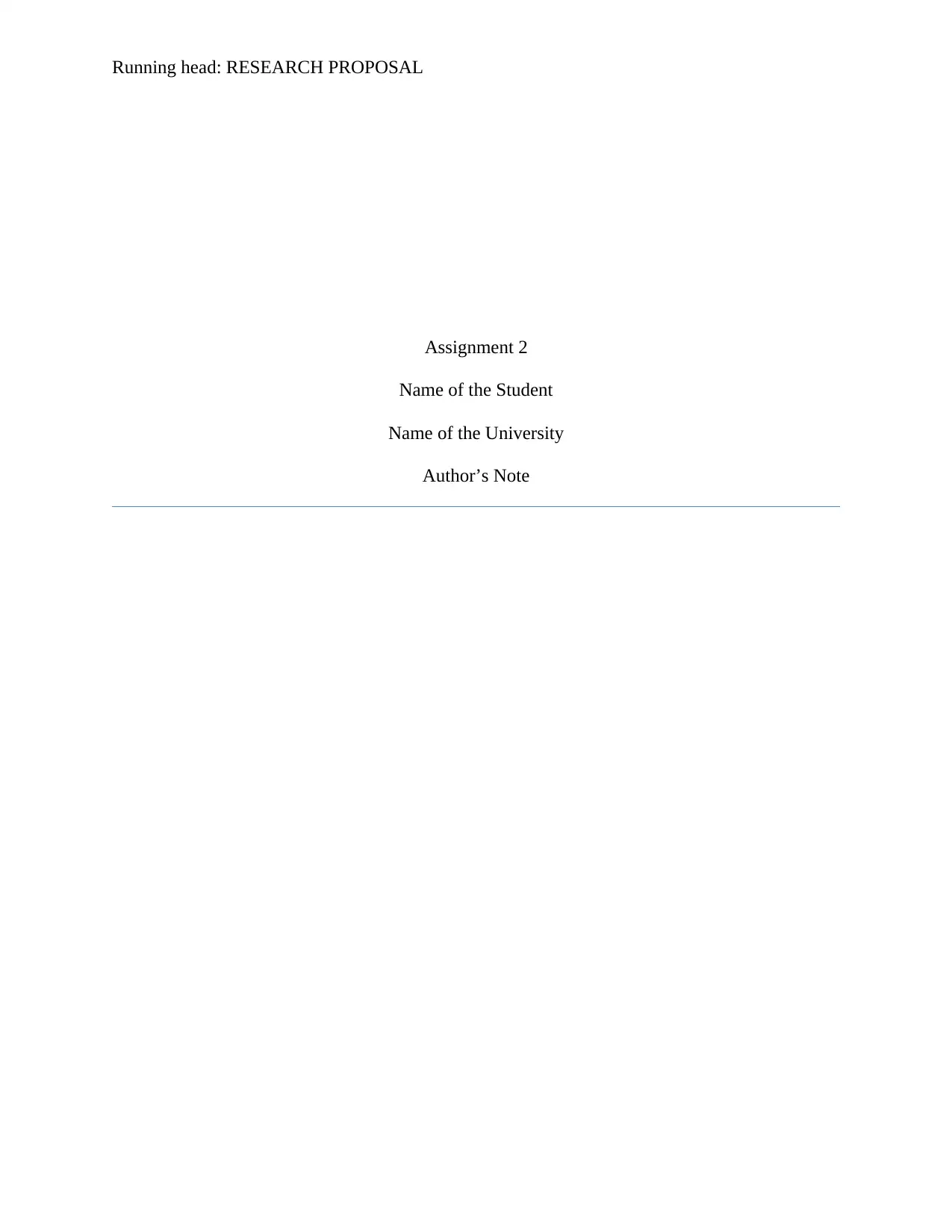
Running head: RESEARCH PROPOSAL
Assignment 2
Name of the Student
Name of the University
Author’s Note
Assignment 2
Name of the Student
Name of the University
Author’s Note
Paraphrase This Document
Need a fresh take? Get an instant paraphrase of this document with our AI Paraphraser
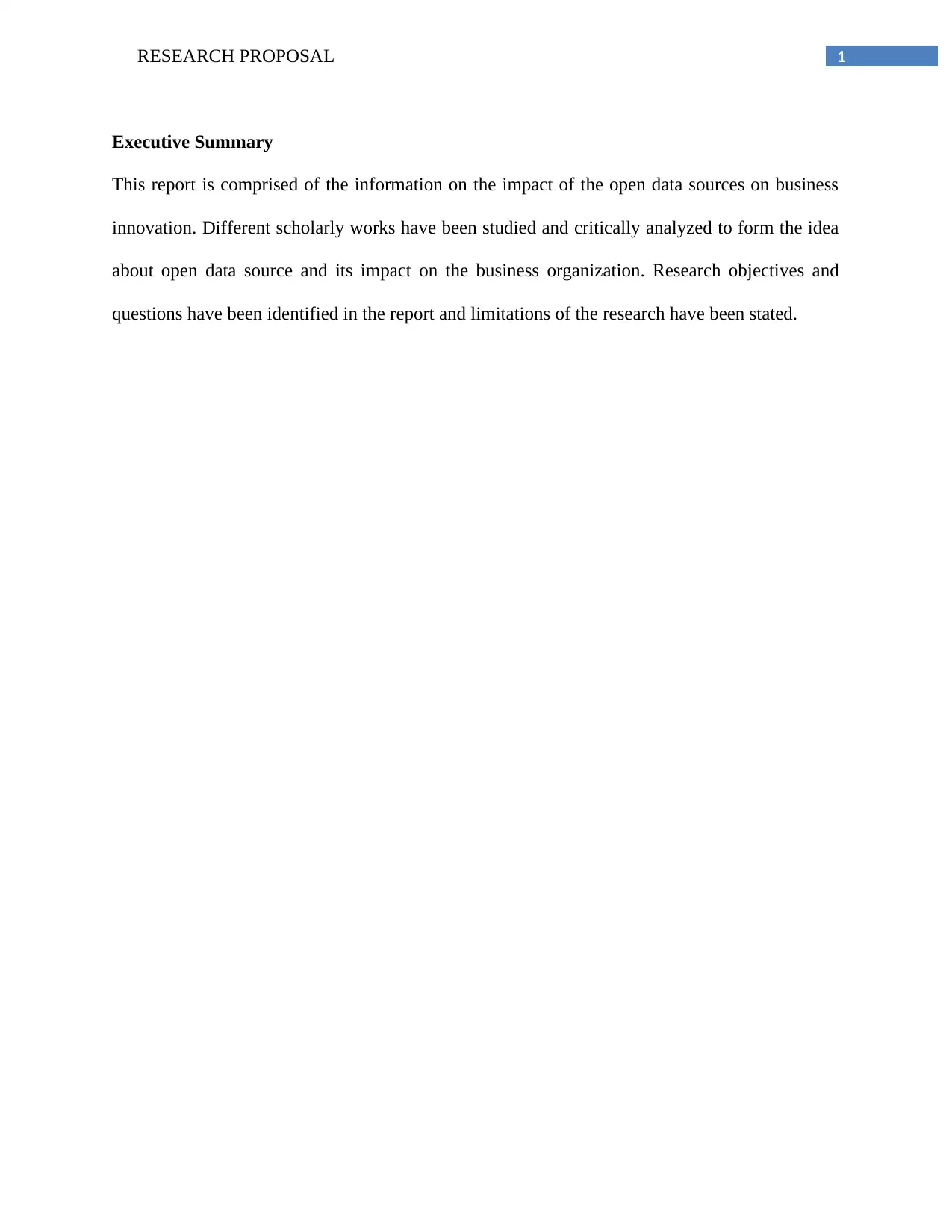
1RESEARCH PROPOSAL
Executive Summary
This report is comprised of the information on the impact of the open data sources on business
innovation. Different scholarly works have been studied and critically analyzed to form the idea
about open data source and its impact on the business organization. Research objectives and
questions have been identified in the report and limitations of the research have been stated.
Executive Summary
This report is comprised of the information on the impact of the open data sources on business
innovation. Different scholarly works have been studied and critically analyzed to form the idea
about open data source and its impact on the business organization. Research objectives and
questions have been identified in the report and limitations of the research have been stated.
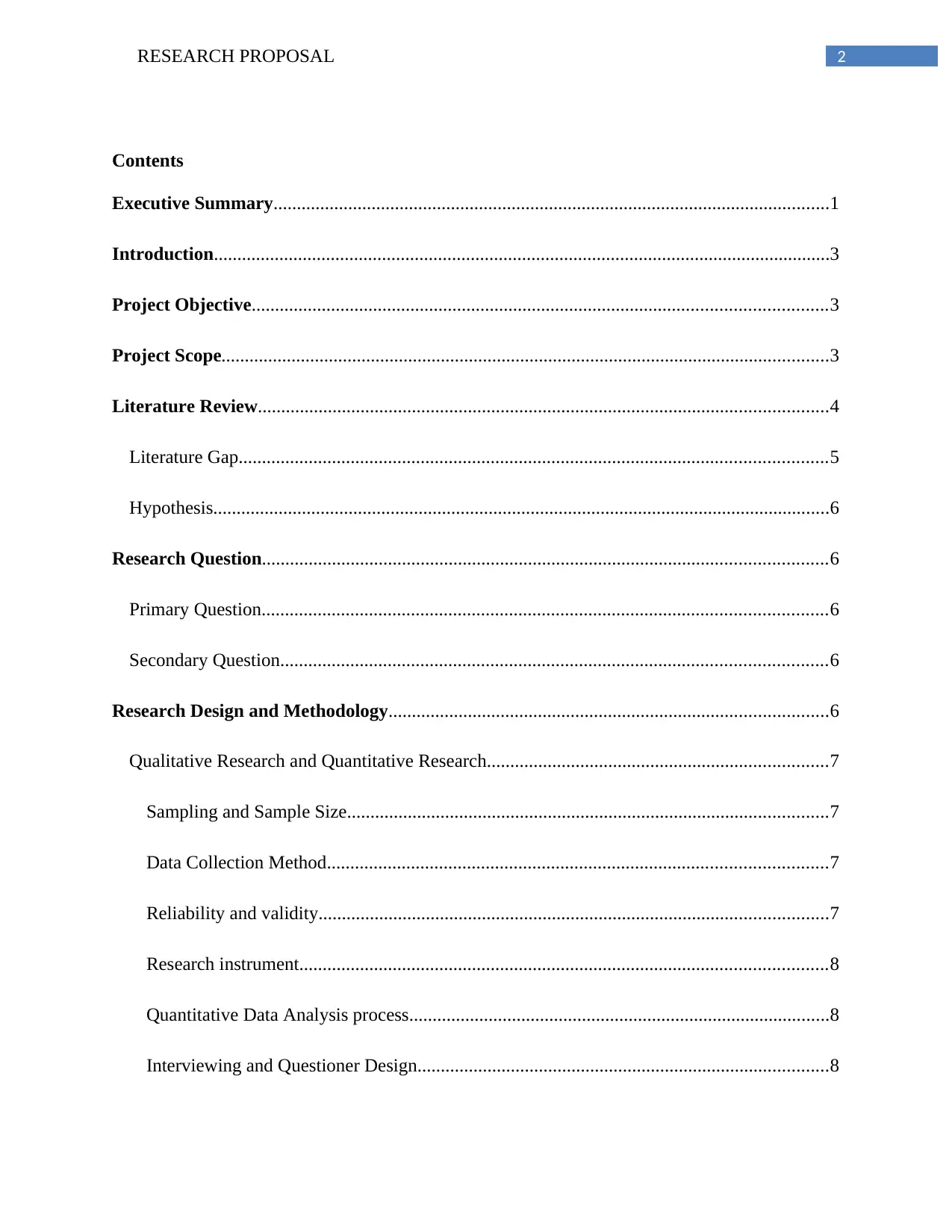
2RESEARCH PROPOSAL
Contents
Executive Summary.......................................................................................................................1
Introduction....................................................................................................................................3
Project Objective...........................................................................................................................3
Project Scope..................................................................................................................................3
Literature Review..........................................................................................................................4
Literature Gap..............................................................................................................................5
Hypothesis....................................................................................................................................6
Research Question.........................................................................................................................6
Primary Question.........................................................................................................................6
Secondary Question.....................................................................................................................6
Research Design and Methodology..............................................................................................6
Qualitative Research and Quantitative Research.........................................................................7
Sampling and Sample Size.......................................................................................................7
Data Collection Method...........................................................................................................7
Reliability and validity.............................................................................................................7
Research instrument.................................................................................................................8
Quantitative Data Analysis process..........................................................................................8
Interviewing and Questioner Design........................................................................................8
Contents
Executive Summary.......................................................................................................................1
Introduction....................................................................................................................................3
Project Objective...........................................................................................................................3
Project Scope..................................................................................................................................3
Literature Review..........................................................................................................................4
Literature Gap..............................................................................................................................5
Hypothesis....................................................................................................................................6
Research Question.........................................................................................................................6
Primary Question.........................................................................................................................6
Secondary Question.....................................................................................................................6
Research Design and Methodology..............................................................................................6
Qualitative Research and Quantitative Research.........................................................................7
Sampling and Sample Size.......................................................................................................7
Data Collection Method...........................................................................................................7
Reliability and validity.............................................................................................................7
Research instrument.................................................................................................................8
Quantitative Data Analysis process..........................................................................................8
Interviewing and Questioner Design........................................................................................8
⊘ This is a preview!⊘
Do you want full access?
Subscribe today to unlock all pages.

Trusted by 1+ million students worldwide
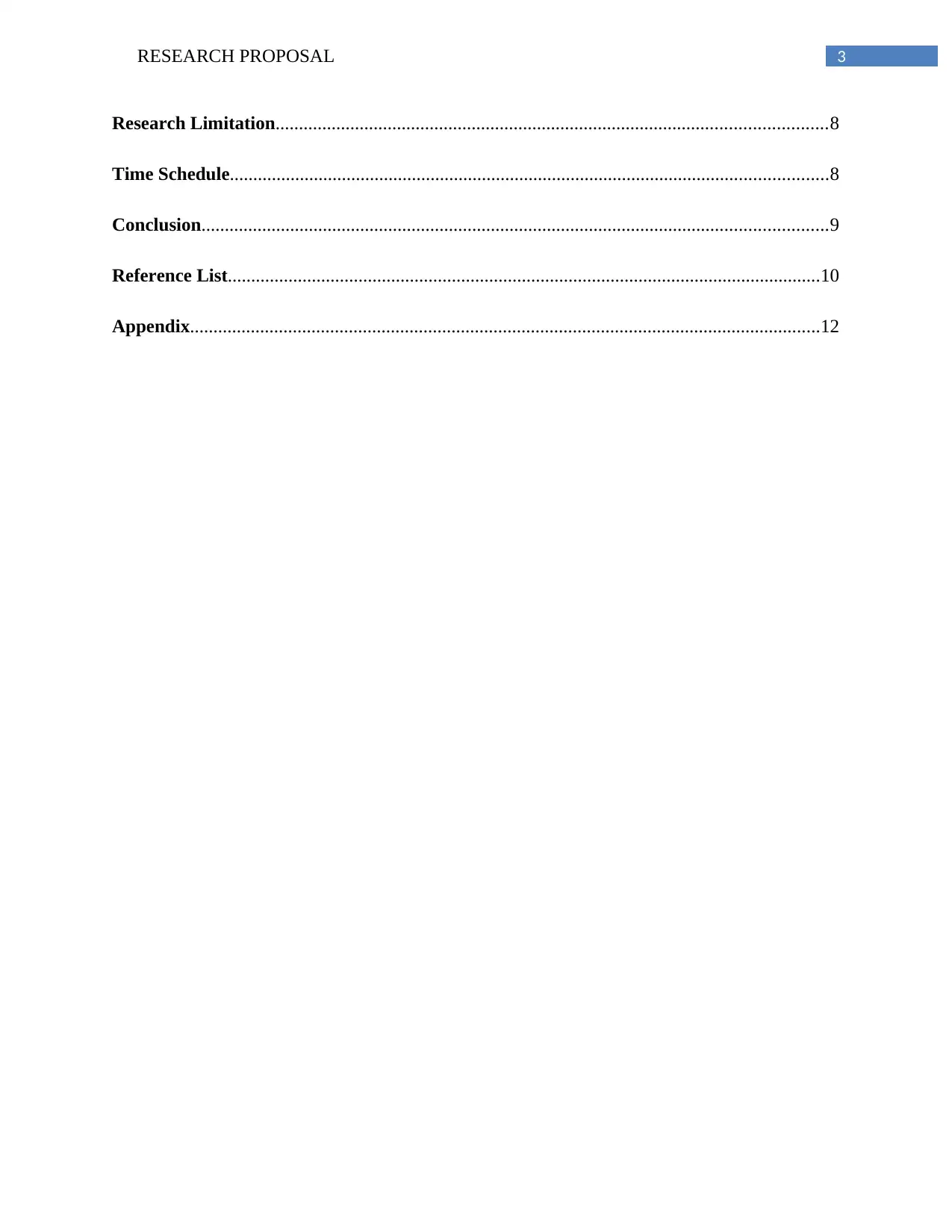
3RESEARCH PROPOSAL
Research Limitation......................................................................................................................8
Time Schedule................................................................................................................................8
Conclusion......................................................................................................................................9
Reference List...............................................................................................................................10
Appendix.......................................................................................................................................12
Research Limitation......................................................................................................................8
Time Schedule................................................................................................................................8
Conclusion......................................................................................................................................9
Reference List...............................................................................................................................10
Appendix.......................................................................................................................................12
Paraphrase This Document
Need a fresh take? Get an instant paraphrase of this document with our AI Paraphraser
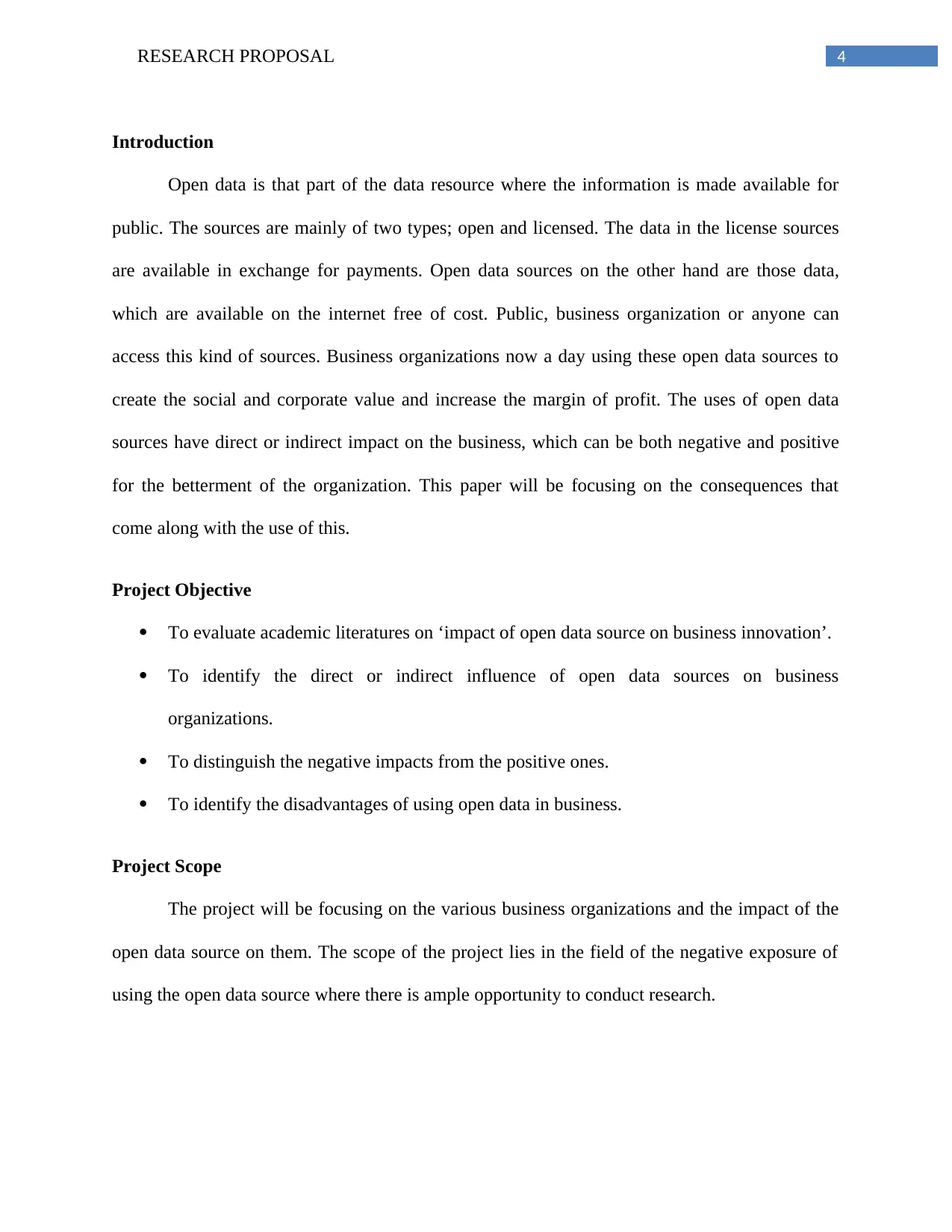
4RESEARCH PROPOSAL
Introduction
Open data is that part of the data resource where the information is made available for
public. The sources are mainly of two types; open and licensed. The data in the license sources
are available in exchange for payments. Open data sources on the other hand are those data,
which are available on the internet free of cost. Public, business organization or anyone can
access this kind of sources. Business organizations now a day using these open data sources to
create the social and corporate value and increase the margin of profit. The uses of open data
sources have direct or indirect impact on the business, which can be both negative and positive
for the betterment of the organization. This paper will be focusing on the consequences that
come along with the use of this.
Project Objective
To evaluate academic literatures on ‘impact of open data source on business innovation’.
To identify the direct or indirect influence of open data sources on business
organizations.
To distinguish the negative impacts from the positive ones.
To identify the disadvantages of using open data in business.
Project Scope
The project will be focusing on the various business organizations and the impact of the
open data source on them. The scope of the project lies in the field of the negative exposure of
using the open data source where there is ample opportunity to conduct research.
Introduction
Open data is that part of the data resource where the information is made available for
public. The sources are mainly of two types; open and licensed. The data in the license sources
are available in exchange for payments. Open data sources on the other hand are those data,
which are available on the internet free of cost. Public, business organization or anyone can
access this kind of sources. Business organizations now a day using these open data sources to
create the social and corporate value and increase the margin of profit. The uses of open data
sources have direct or indirect impact on the business, which can be both negative and positive
for the betterment of the organization. This paper will be focusing on the consequences that
come along with the use of this.
Project Objective
To evaluate academic literatures on ‘impact of open data source on business innovation’.
To identify the direct or indirect influence of open data sources on business
organizations.
To distinguish the negative impacts from the positive ones.
To identify the disadvantages of using open data in business.
Project Scope
The project will be focusing on the various business organizations and the impact of the
open data source on them. The scope of the project lies in the field of the negative exposure of
using the open data source where there is ample opportunity to conduct research.
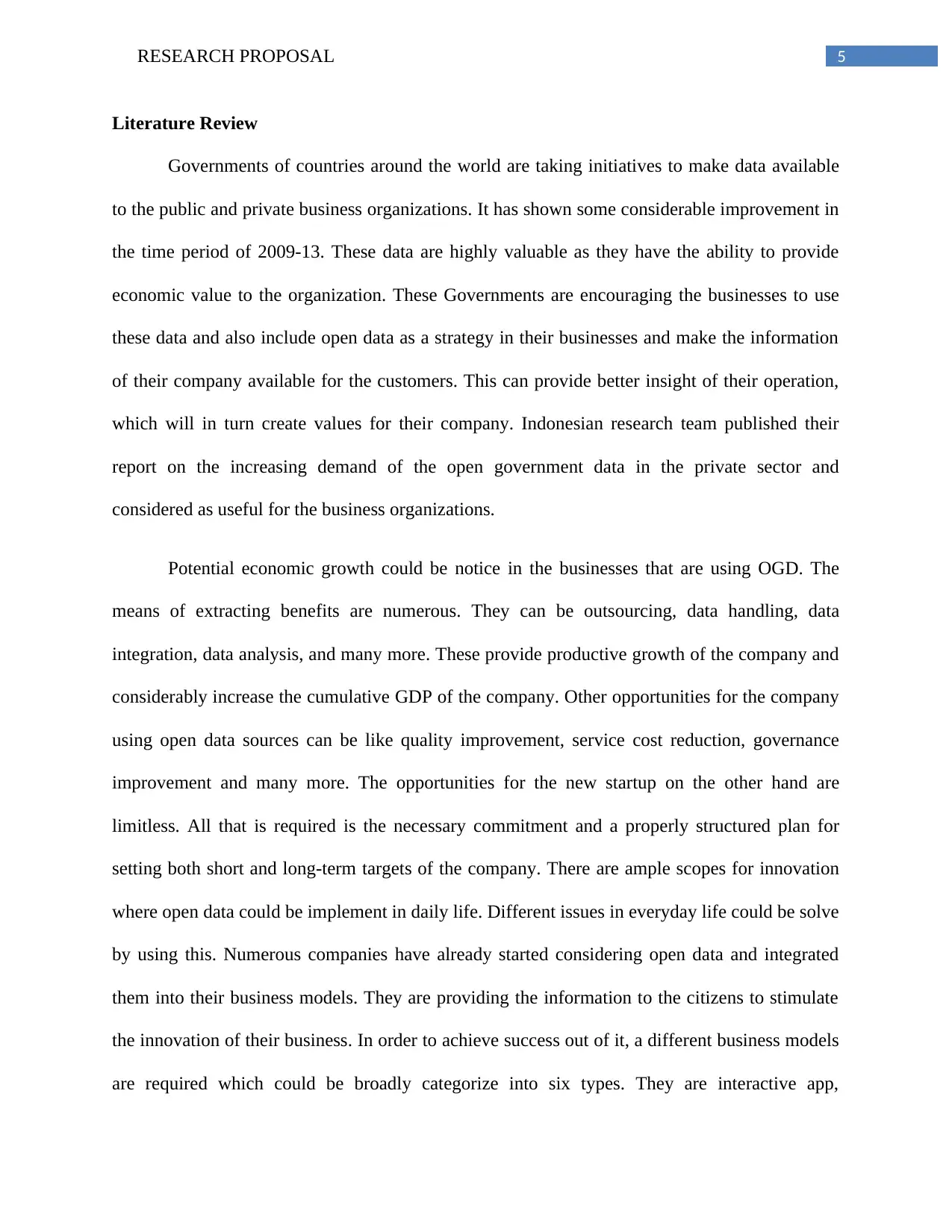
5RESEARCH PROPOSAL
Literature Review
Governments of countries around the world are taking initiatives to make data available
to the public and private business organizations. It has shown some considerable improvement in
the time period of 2009-13. These data are highly valuable as they have the ability to provide
economic value to the organization. These Governments are encouraging the businesses to use
these data and also include open data as a strategy in their businesses and make the information
of their company available for the customers. This can provide better insight of their operation,
which will in turn create values for their company. Indonesian research team published their
report on the increasing demand of the open government data in the private sector and
considered as useful for the business organizations.
Potential economic growth could be notice in the businesses that are using OGD. The
means of extracting benefits are numerous. They can be outsourcing, data handling, data
integration, data analysis, and many more. These provide productive growth of the company and
considerably increase the cumulative GDP of the company. Other opportunities for the company
using open data sources can be like quality improvement, service cost reduction, governance
improvement and many more. The opportunities for the new startup on the other hand are
limitless. All that is required is the necessary commitment and a properly structured plan for
setting both short and long-term targets of the company. There are ample scopes for innovation
where open data could be implement in daily life. Different issues in everyday life could be solve
by using this. Numerous companies have already started considering open data and integrated
them into their business models. They are providing the information to the citizens to stimulate
the innovation of their business. In order to achieve success out of it, a different business models
are required which could be broadly categorize into six types. They are interactive app,
Literature Review
Governments of countries around the world are taking initiatives to make data available
to the public and private business organizations. It has shown some considerable improvement in
the time period of 2009-13. These data are highly valuable as they have the ability to provide
economic value to the organization. These Governments are encouraging the businesses to use
these data and also include open data as a strategy in their businesses and make the information
of their company available for the customers. This can provide better insight of their operation,
which will in turn create values for their company. Indonesian research team published their
report on the increasing demand of the open government data in the private sector and
considered as useful for the business organizations.
Potential economic growth could be notice in the businesses that are using OGD. The
means of extracting benefits are numerous. They can be outsourcing, data handling, data
integration, data analysis, and many more. These provide productive growth of the company and
considerably increase the cumulative GDP of the company. Other opportunities for the company
using open data sources can be like quality improvement, service cost reduction, governance
improvement and many more. The opportunities for the new startup on the other hand are
limitless. All that is required is the necessary commitment and a properly structured plan for
setting both short and long-term targets of the company. There are ample scopes for innovation
where open data could be implement in daily life. Different issues in everyday life could be solve
by using this. Numerous companies have already started considering open data and integrated
them into their business models. They are providing the information to the citizens to stimulate
the innovation of their business. In order to achieve success out of it, a different business models
are required which could be broadly categorize into six types. They are interactive app,
⊘ This is a preview!⊘
Do you want full access?
Subscribe today to unlock all pages.

Trusted by 1+ million students worldwide
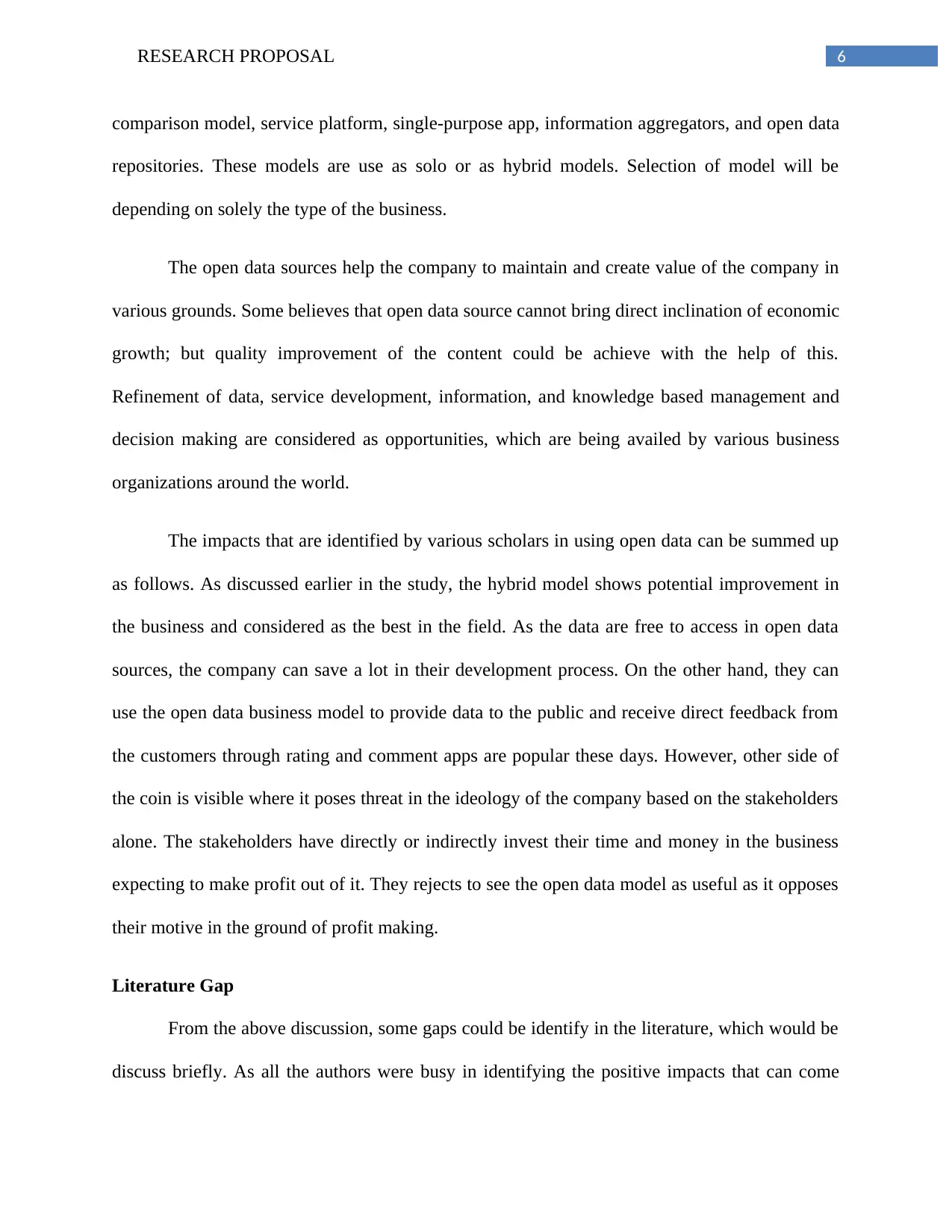
6RESEARCH PROPOSAL
comparison model, service platform, single-purpose app, information aggregators, and open data
repositories. These models are use as solo or as hybrid models. Selection of model will be
depending on solely the type of the business.
The open data sources help the company to maintain and create value of the company in
various grounds. Some believes that open data source cannot bring direct inclination of economic
growth; but quality improvement of the content could be achieve with the help of this.
Refinement of data, service development, information, and knowledge based management and
decision making are considered as opportunities, which are being availed by various business
organizations around the world.
The impacts that are identified by various scholars in using open data can be summed up
as follows. As discussed earlier in the study, the hybrid model shows potential improvement in
the business and considered as the best in the field. As the data are free to access in open data
sources, the company can save a lot in their development process. On the other hand, they can
use the open data business model to provide data to the public and receive direct feedback from
the customers through rating and comment apps are popular these days. However, other side of
the coin is visible where it poses threat in the ideology of the company based on the stakeholders
alone. The stakeholders have directly or indirectly invest their time and money in the business
expecting to make profit out of it. They rejects to see the open data model as useful as it opposes
their motive in the ground of profit making.
Literature Gap
From the above discussion, some gaps could be identify in the literature, which would be
discuss briefly. As all the authors were busy in identifying the positive impacts that can come
comparison model, service platform, single-purpose app, information aggregators, and open data
repositories. These models are use as solo or as hybrid models. Selection of model will be
depending on solely the type of the business.
The open data sources help the company to maintain and create value of the company in
various grounds. Some believes that open data source cannot bring direct inclination of economic
growth; but quality improvement of the content could be achieve with the help of this.
Refinement of data, service development, information, and knowledge based management and
decision making are considered as opportunities, which are being availed by various business
organizations around the world.
The impacts that are identified by various scholars in using open data can be summed up
as follows. As discussed earlier in the study, the hybrid model shows potential improvement in
the business and considered as the best in the field. As the data are free to access in open data
sources, the company can save a lot in their development process. On the other hand, they can
use the open data business model to provide data to the public and receive direct feedback from
the customers through rating and comment apps are popular these days. However, other side of
the coin is visible where it poses threat in the ideology of the company based on the stakeholders
alone. The stakeholders have directly or indirectly invest their time and money in the business
expecting to make profit out of it. They rejects to see the open data model as useful as it opposes
their motive in the ground of profit making.
Literature Gap
From the above discussion, some gaps could be identify in the literature, which would be
discuss briefly. As all the authors were busy in identifying the positive impacts that can come
Paraphrase This Document
Need a fresh take? Get an instant paraphrase of this document with our AI Paraphraser
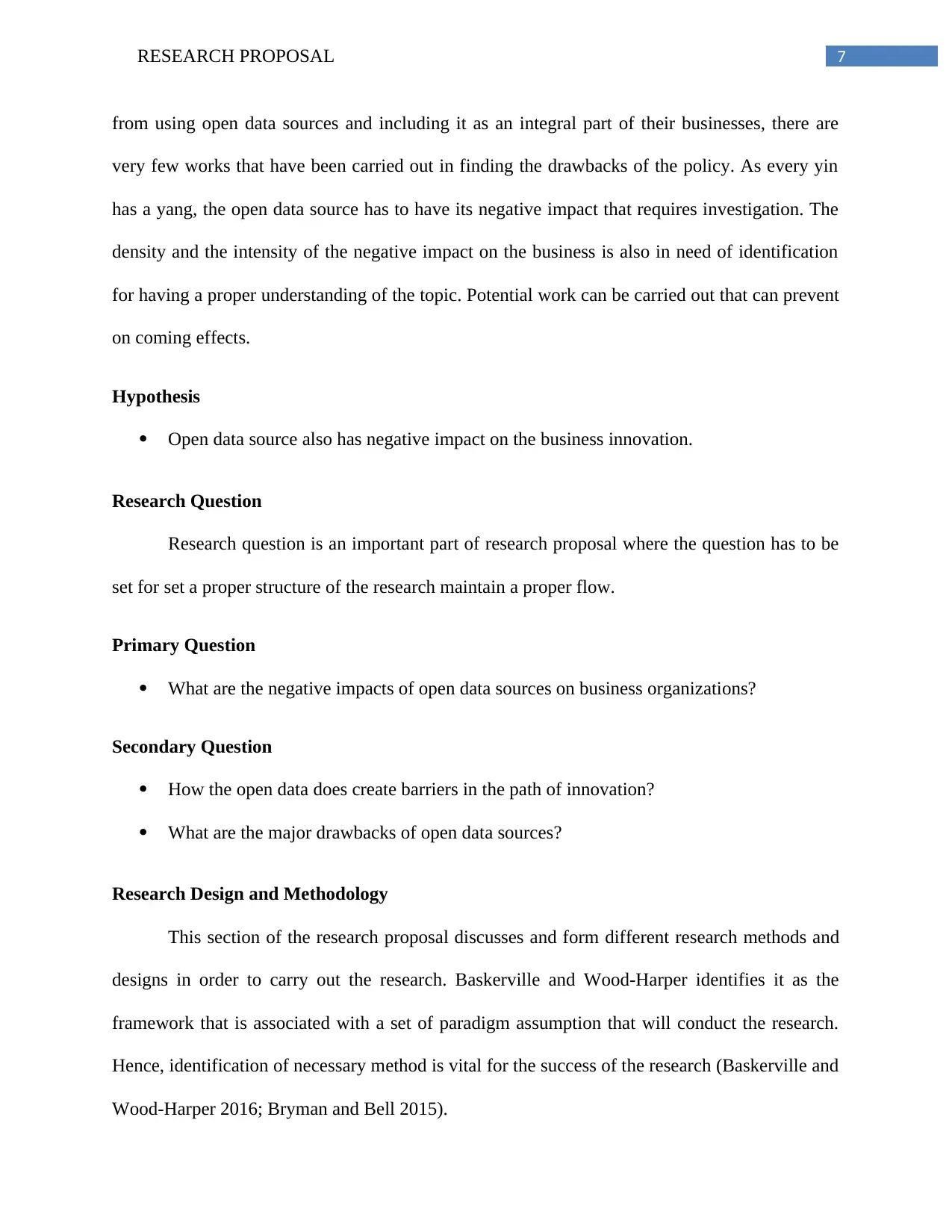
7RESEARCH PROPOSAL
from using open data sources and including it as an integral part of their businesses, there are
very few works that have been carried out in finding the drawbacks of the policy. As every yin
has a yang, the open data source has to have its negative impact that requires investigation. The
density and the intensity of the negative impact on the business is also in need of identification
for having a proper understanding of the topic. Potential work can be carried out that can prevent
on coming effects.
Hypothesis
Open data source also has negative impact on the business innovation.
Research Question
Research question is an important part of research proposal where the question has to be
set for set a proper structure of the research maintain a proper flow.
Primary Question
What are the negative impacts of open data sources on business organizations?
Secondary Question
How the open data does create barriers in the path of innovation?
What are the major drawbacks of open data sources?
Research Design and Methodology
This section of the research proposal discusses and form different research methods and
designs in order to carry out the research. Baskerville and Wood-Harper identifies it as the
framework that is associated with a set of paradigm assumption that will conduct the research.
Hence, identification of necessary method is vital for the success of the research (Baskerville and
Wood-Harper 2016; Bryman and Bell 2015).
from using open data sources and including it as an integral part of their businesses, there are
very few works that have been carried out in finding the drawbacks of the policy. As every yin
has a yang, the open data source has to have its negative impact that requires investigation. The
density and the intensity of the negative impact on the business is also in need of identification
for having a proper understanding of the topic. Potential work can be carried out that can prevent
on coming effects.
Hypothesis
Open data source also has negative impact on the business innovation.
Research Question
Research question is an important part of research proposal where the question has to be
set for set a proper structure of the research maintain a proper flow.
Primary Question
What are the negative impacts of open data sources on business organizations?
Secondary Question
How the open data does create barriers in the path of innovation?
What are the major drawbacks of open data sources?
Research Design and Methodology
This section of the research proposal discusses and form different research methods and
designs in order to carry out the research. Baskerville and Wood-Harper identifies it as the
framework that is associated with a set of paradigm assumption that will conduct the research.
Hence, identification of necessary method is vital for the success of the research (Baskerville and
Wood-Harper 2016; Bryman and Bell 2015).
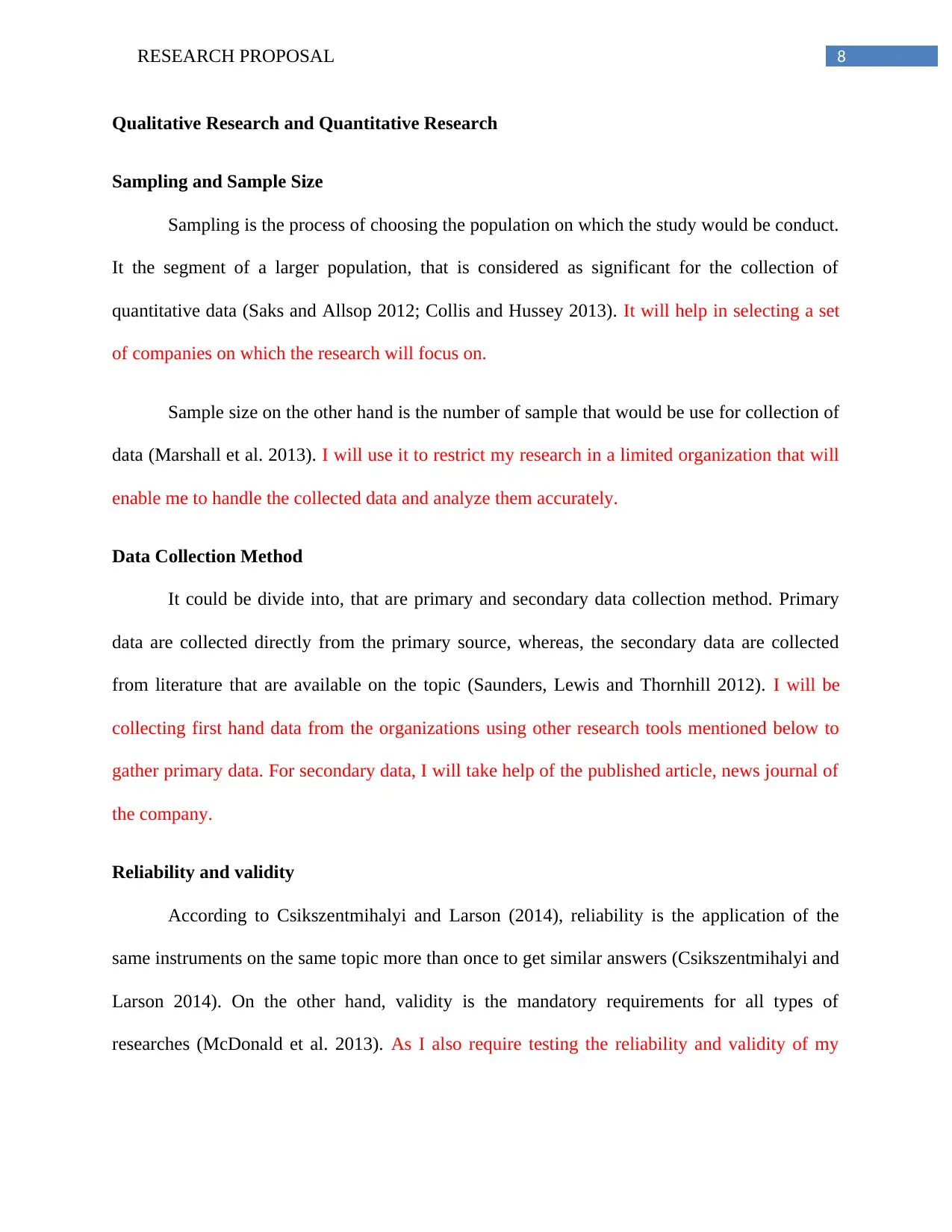
8RESEARCH PROPOSAL
Qualitative Research and Quantitative Research
Sampling and Sample Size
Sampling is the process of choosing the population on which the study would be conduct.
It the segment of a larger population, that is considered as significant for the collection of
quantitative data (Saks and Allsop 2012; Collis and Hussey 2013). It will help in selecting a set
of companies on which the research will focus on.
Sample size on the other hand is the number of sample that would be use for collection of
data (Marshall et al. 2013). I will use it to restrict my research in a limited organization that will
enable me to handle the collected data and analyze them accurately.
Data Collection Method
It could be divide into, that are primary and secondary data collection method. Primary
data are collected directly from the primary source, whereas, the secondary data are collected
from literature that are available on the topic (Saunders, Lewis and Thornhill 2012). I will be
collecting first hand data from the organizations using other research tools mentioned below to
gather primary data. For secondary data, I will take help of the published article, news journal of
the company.
Reliability and validity
According to Csikszentmihalyi and Larson (2014), reliability is the application of the
same instruments on the same topic more than once to get similar answers (Csikszentmihalyi and
Larson 2014). On the other hand, validity is the mandatory requirements for all types of
researches (McDonald et al. 2013). As I also require testing the reliability and validity of my
Qualitative Research and Quantitative Research
Sampling and Sample Size
Sampling is the process of choosing the population on which the study would be conduct.
It the segment of a larger population, that is considered as significant for the collection of
quantitative data (Saks and Allsop 2012; Collis and Hussey 2013). It will help in selecting a set
of companies on which the research will focus on.
Sample size on the other hand is the number of sample that would be use for collection of
data (Marshall et al. 2013). I will use it to restrict my research in a limited organization that will
enable me to handle the collected data and analyze them accurately.
Data Collection Method
It could be divide into, that are primary and secondary data collection method. Primary
data are collected directly from the primary source, whereas, the secondary data are collected
from literature that are available on the topic (Saunders, Lewis and Thornhill 2012). I will be
collecting first hand data from the organizations using other research tools mentioned below to
gather primary data. For secondary data, I will take help of the published article, news journal of
the company.
Reliability and validity
According to Csikszentmihalyi and Larson (2014), reliability is the application of the
same instruments on the same topic more than once to get similar answers (Csikszentmihalyi and
Larson 2014). On the other hand, validity is the mandatory requirements for all types of
researches (McDonald et al. 2013). As I also require testing the reliability and validity of my
⊘ This is a preview!⊘
Do you want full access?
Subscribe today to unlock all pages.

Trusted by 1+ million students worldwide
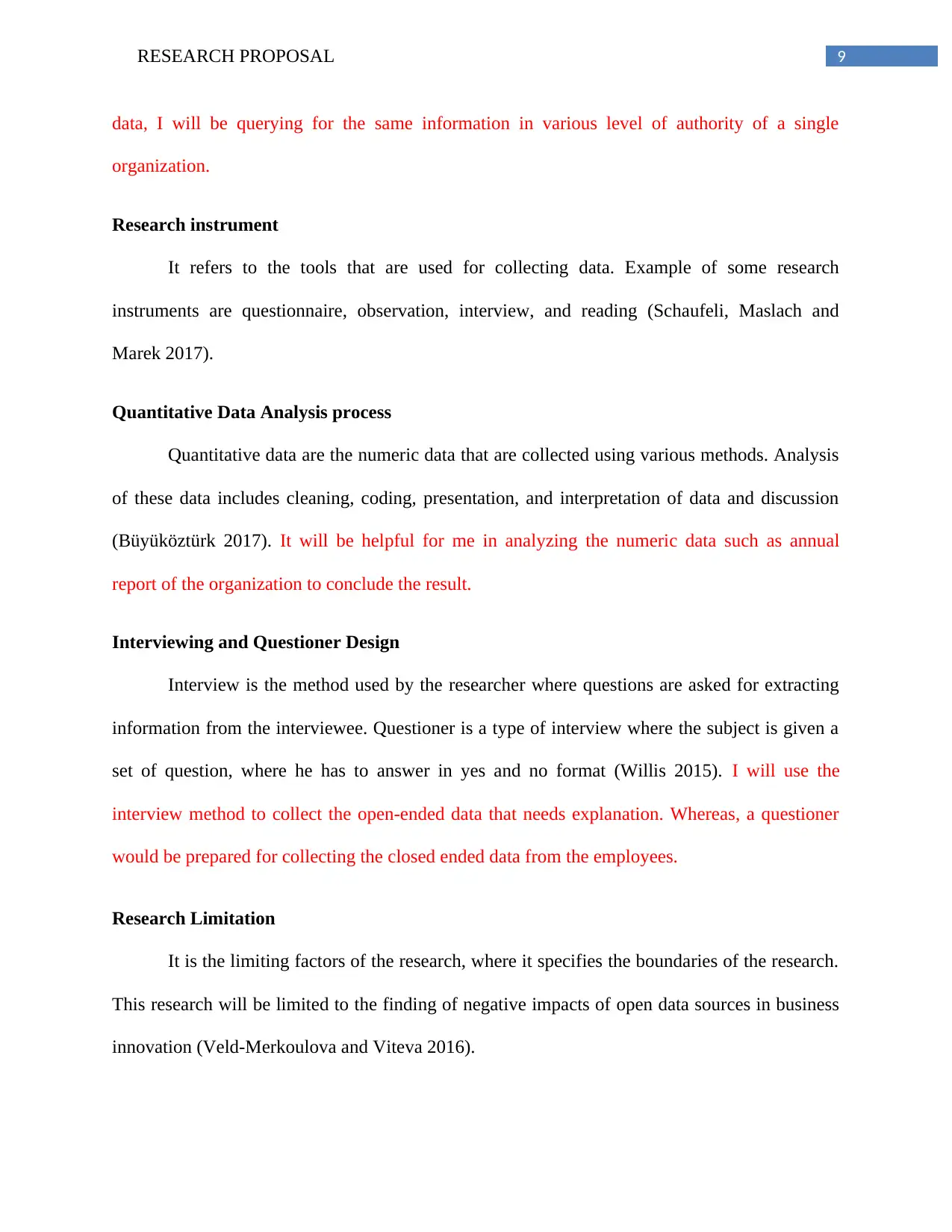
9RESEARCH PROPOSAL
data, I will be querying for the same information in various level of authority of a single
organization.
Research instrument
It refers to the tools that are used for collecting data. Example of some research
instruments are questionnaire, observation, interview, and reading (Schaufeli, Maslach and
Marek 2017).
Quantitative Data Analysis process
Quantitative data are the numeric data that are collected using various methods. Analysis
of these data includes cleaning, coding, presentation, and interpretation of data and discussion
(Büyüköztürk 2017). It will be helpful for me in analyzing the numeric data such as annual
report of the organization to conclude the result.
Interviewing and Questioner Design
Interview is the method used by the researcher where questions are asked for extracting
information from the interviewee. Questioner is a type of interview where the subject is given a
set of question, where he has to answer in yes and no format (Willis 2015). I will use the
interview method to collect the open-ended data that needs explanation. Whereas, a questioner
would be prepared for collecting the closed ended data from the employees.
Research Limitation
It is the limiting factors of the research, where it specifies the boundaries of the research.
This research will be limited to the finding of negative impacts of open data sources in business
innovation (Veld-Merkoulova and Viteva 2016).
data, I will be querying for the same information in various level of authority of a single
organization.
Research instrument
It refers to the tools that are used for collecting data. Example of some research
instruments are questionnaire, observation, interview, and reading (Schaufeli, Maslach and
Marek 2017).
Quantitative Data Analysis process
Quantitative data are the numeric data that are collected using various methods. Analysis
of these data includes cleaning, coding, presentation, and interpretation of data and discussion
(Büyüköztürk 2017). It will be helpful for me in analyzing the numeric data such as annual
report of the organization to conclude the result.
Interviewing and Questioner Design
Interview is the method used by the researcher where questions are asked for extracting
information from the interviewee. Questioner is a type of interview where the subject is given a
set of question, where he has to answer in yes and no format (Willis 2015). I will use the
interview method to collect the open-ended data that needs explanation. Whereas, a questioner
would be prepared for collecting the closed ended data from the employees.
Research Limitation
It is the limiting factors of the research, where it specifies the boundaries of the research.
This research will be limited to the finding of negative impacts of open data sources in business
innovation (Veld-Merkoulova and Viteva 2016).
Paraphrase This Document
Need a fresh take? Get an instant paraphrase of this document with our AI Paraphraser
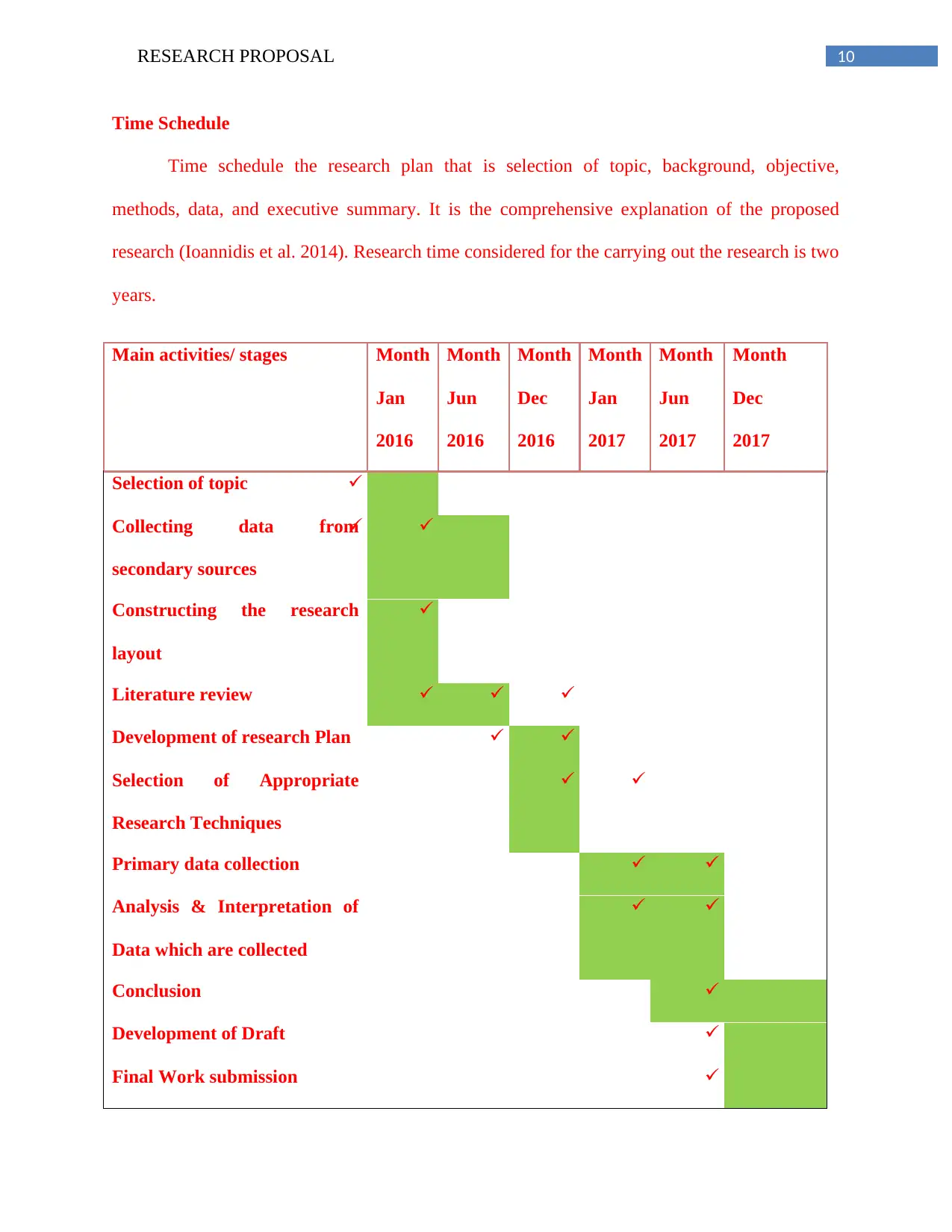
10RESEARCH PROPOSAL
Time Schedule
Time schedule the research plan that is selection of topic, background, objective,
methods, data, and executive summary. It is the comprehensive explanation of the proposed
research (Ioannidis et al. 2014). Research time considered for the carrying out the research is two
years.
Main activities/ stages Month
Jan
2016
Month
Jun
2016
Month
Dec
2016
Month
Jan
2017
Month
Jun
2017
Month
Dec
2017
Selection of topic
Collecting data from
secondary sources
Constructing the research
layout
Literature review
Development of research Plan
Selection of Appropriate
Research Techniques
Primary data collection
Analysis & Interpretation of
Data which are collected
Conclusion
Development of Draft
Final Work submission
Time Schedule
Time schedule the research plan that is selection of topic, background, objective,
methods, data, and executive summary. It is the comprehensive explanation of the proposed
research (Ioannidis et al. 2014). Research time considered for the carrying out the research is two
years.
Main activities/ stages Month
Jan
2016
Month
Jun
2016
Month
Dec
2016
Month
Jan
2017
Month
Jun
2017
Month
Dec
2017
Selection of topic
Collecting data from
secondary sources
Constructing the research
layout
Literature review
Development of research Plan
Selection of Appropriate
Research Techniques
Primary data collection
Analysis & Interpretation of
Data which are collected
Conclusion
Development of Draft
Final Work submission
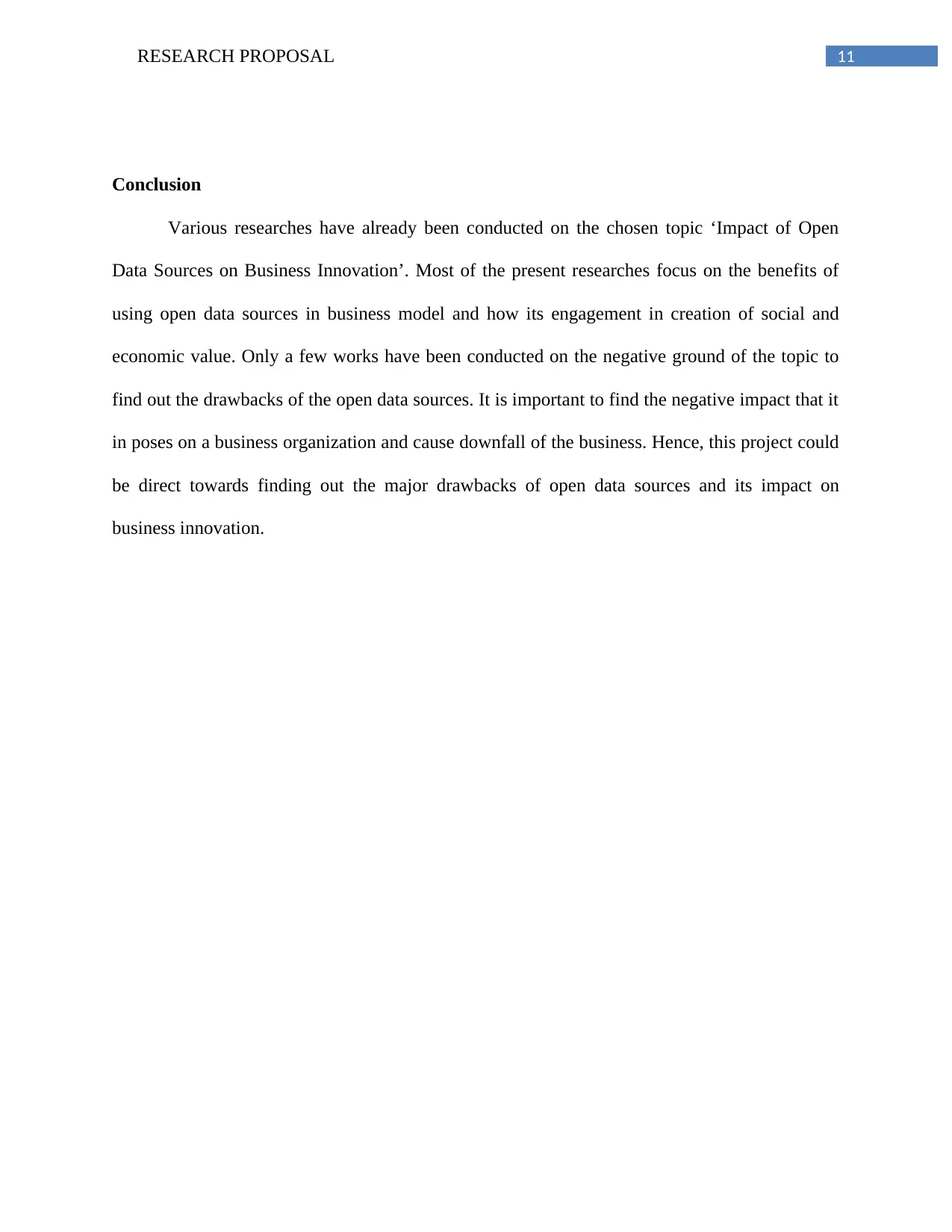
11RESEARCH PROPOSAL
Conclusion
Various researches have already been conducted on the chosen topic ‘Impact of Open
Data Sources on Business Innovation’. Most of the present researches focus on the benefits of
using open data sources in business model and how its engagement in creation of social and
economic value. Only a few works have been conducted on the negative ground of the topic to
find out the drawbacks of the open data sources. It is important to find the negative impact that it
in poses on a business organization and cause downfall of the business. Hence, this project could
be direct towards finding out the major drawbacks of open data sources and its impact on
business innovation.
Conclusion
Various researches have already been conducted on the chosen topic ‘Impact of Open
Data Sources on Business Innovation’. Most of the present researches focus on the benefits of
using open data sources in business model and how its engagement in creation of social and
economic value. Only a few works have been conducted on the negative ground of the topic to
find out the drawbacks of the open data sources. It is important to find the negative impact that it
in poses on a business organization and cause downfall of the business. Hence, this project could
be direct towards finding out the major drawbacks of open data sources and its impact on
business innovation.
⊘ This is a preview!⊘
Do you want full access?
Subscribe today to unlock all pages.

Trusted by 1+ million students worldwide
1 out of 15
Related Documents
Your All-in-One AI-Powered Toolkit for Academic Success.
+13062052269
info@desklib.com
Available 24*7 on WhatsApp / Email
![[object Object]](/_next/static/media/star-bottom.7253800d.svg)
Unlock your academic potential
Copyright © 2020–2025 A2Z Services. All Rights Reserved. Developed and managed by ZUCOL.





